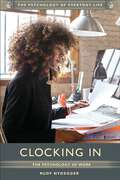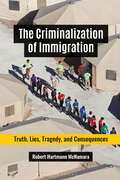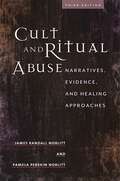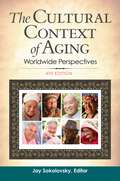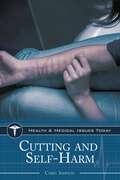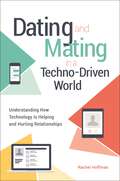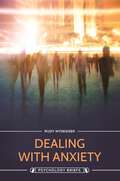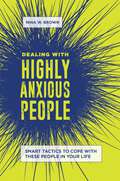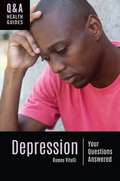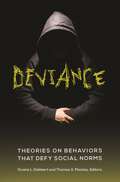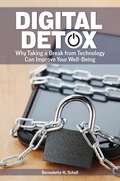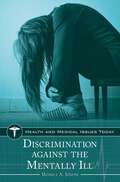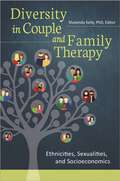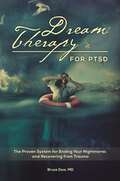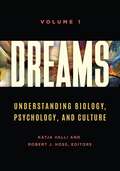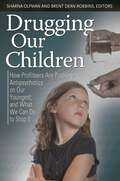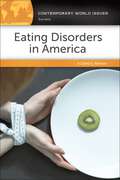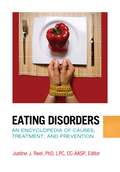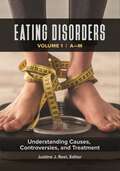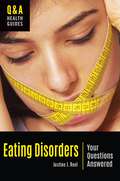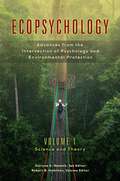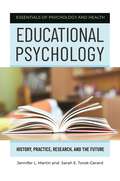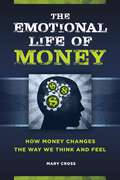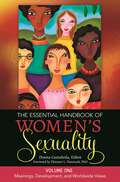- Table View
- List View
Clocking In: The Psychology of Work (The Psychology of Everyday Life)
by Rudy NydeggerCovering important topics such as job satisfaction, workplace stress, and the changing nature of jobs and careers in the 21st century, this valuable resource explores how working affects us psychologically, for better and for worse and sometimes in imperceptible ways.Although most people go to work Monday through Friday, few stop to think about the central role work plays in our lives. Besides allowing us to provide for the material needs of ourselves and our families, having a job or career can help us to meet new people and stay socially connected, to increase our self-esteem and sense of self-worth, and to allow us to have an impact on the world. But work can also leave us exhausted and stressed, and many people find it difficult to balance their work and personal lives.This clear and accessibly written book in Greenwood's Psychology of Everyday Life series provides readers with an understanding of the important roles work plays in our lives, the many forms work may take, and the ways in which our relationships with work change throughout our lives. The information, presented in an unassuming, easy-to-understand manner, is drawn from classical theory as well as from contemporary research, affording readers a well-rounded understanding of the topic. The book also includes a collection of real-world scenarios to illustrate key concepts as well as scholarly essays offering perspective on current issues and debates related to work in America.
Criminal Psychology [4 volumes]: [4 volumes]
by Jacqueline B. HelfgottThis comprehensive, four-volume reference set on the subject of criminal psychology includes contributions from top scholars and practitioners in the field, explaining new and emerging theory and research in the study of the criminal mind and criminal behavior.Unfortunately, criminal behavior surrounds us in our society—from petty theft and vandalism to multimillion-dollar white-collar crime to shocking terrorism attempts and school killings. Invariably, one of the first questions is, "Why did they do it?" Criminal psychology seeks to solve this complex puzzle.In this four-volume reference work, a unparalleled team of leading experts offer an exhaustive look at the history, developments, emerging and classic research issues, controversies, and victories in the expanding field of criminal psychology. The first volume examines the general theories in the study of criminal psychology. The second volume focuses more specifically on research of criminal behavior and crime types, while the last two volumes delve into criminal justice and forensic applications. The comprehensive content allows readers to better understand criminal behavior and appreciate the specific criminal justice and forensic settings in which this theory and research is applied, such as criminal profiling, forensic assessment of danger, and correctional rehabilitation and offender reentry.
The Criminalization of Immigration: Truth, Lies, Tragedy, and Consequences
by Robert Hartmann McNamaraPresents the history of immigration to the United States; its criminalization under the Trump administration; debates over criminalization; effects on immigrants, U.S. residents, and the U.S. economy; and this country's relationships with other nations.This book offers a comprehensive understanding of past and current immigration policy in the United States and exposes falsehoods in the rhetoric and narrative portraying Latino and Mexican immigrants in the U.S. Much support for intensified immigration enforcement and deportation is based on repeated statements by federal officials, including the U.S. president, that immigrants pose a threat to national security, contribute to crime, and take jobs away from native-born residents. The evidence has consistently concluded that these narratives are inaccurate.This text examines white nationalism as a backdrop to understanding the rationale behind current immigration policy and tactics. It examines how political and economic factors, broadly defined as neoliberal policies, shape the immigration narrative. It addresses the criminal justice system's applicability to immigration, law enforcement efforts, problems with immigration courts and judges, and how the detention of immigrants is part of a larger mass incarceration of people of color. Finally, the text offers insight into the reasons for massive migration, with the U.S. contributing to the problem by supporting regimes that endorse or allow humanitarian crisis.
Cult and Ritual Abuse: Narratives, Evidence, and Healing Approaches
by James Randall Noblitt Pamela Perskin NoblittThis personal yet scholarly journey into the confusing and clandestine world of ritual abuse survivors sheds light on their catastrophic experiences and their efforts to heal afterward.Revised, updated, and expanded, this third edition of a classic study is one of the most authoritative and evenhanded volumes to tackle its hotly debated subject matter. Incorporating the authors' firsthand observations, the book provides historical, anthropological, and psychological context for contemporary reports of both ritual abuse and ritual crime.In addition to sharing patient vignettes and a history of cult and ritual abuse in society, the authors explore fascinating topics related to these practices, among them what triggers personality shifts for victims even many years after the abuse has stopped. Importantly, the book shows how ritual abuse affects society as a whole, influencing civil and criminal law, politics, legislation, social movements, social welfare, and psychological theory. It provides unique insights into the scientific study, forensic investigation, and implementation of social services for survivors of cult and ritual abuse, discusses new research and treatment strategies, and establishes the foundation for a psychological diagnosis to be called Cult and Ritual Trauma Disorder.
The Cultural Context of Aging: Worldwide Perspectives
by Jay SokolovskyFrom the laughing clubs of India and robotic granny minders of Japan to the "Flexsecurity" system of Denmark and the elderscapes of Florida, experts in this collection bring readers cutting-edge and future-focused approaches to our aging population worldwide.In this fourth edition of an award-winning text on the consequences of global aging, a team of expert anthropologists and other social scientists presents the issues and possible solutions as our population over age 60 rises to double that of the year 2000. Chapters describe how the consequences of global aging will influence life in the 21st century in relation to biological limits on the human life span, cultural construction of the life cycle, generational exchange and kinship, makeup of households and community, and attitudes toward disability and death. This completely revised edition includes 20 new chapters covering China, Japan, Denmark, India, West and East Africa, Indonesia, Mexico, Peru, indigenous Amazonia, rural Italy, and the ethnic landscape of the United States. A popular feature is an integrated set of web book chapters listed in the contents, discussed in chapter introductions, and available on the book's web site.
Cutting and Self-Harm (Health and Medical Issues Today)
by Chris Simpson Ph.D.What is self-harm and what causes it? Learn the terms and concepts related to this type of behavior.Non-suicidal self-injury has been in existence to some extent for centuries. Today, the practices are increasing in terms of the number of people engaging in this often-baffling behavior. By the use of accessible language, rich descriptions of concepts, and realistic case examples, Cutting and Self Harm seeks to demystify these behaviors that afflict self-injuring individuals and negatively impact their family members and friends.Author Chris Simpson, PhD, has written and presented on the subject of self-harm since 2001. He begins the book by answering the question "What is cutting and self-harm and how does it occur?" and by explaining important terms and concepts related to the behavior. He then covers current controversies about self-harming behaviors and addresses frequently confusing topics, such as the contributing factors to self-injury, psychopharmacological treatment of the behavior, and the use of group therapeutic approaches in treatment facilities. The final section of the book presents additional resources for those impacted by self-injury.
Dating and Mating in a Techno-Driven World: Understanding How Technology Is Helping and Hurting Relationships (Sex, Love, and Psychology)
by Rachel HoffmanAuthored by a sex therapist who regularly works with clients wanting to improve their relationships, this book explains how technology can create conflict or additional anxiety and discloses techniques to help individuals gain confidence or strengthen their personal relationships.The statistics are telling: 85 percent of all adults use the Internet; 88 percent use email; 91 percent own cell phones; 56 percent own smartphones; 73 percent send and receive text messages; and 67 percent use social networking sites. The advent of personal communication devices and ubiquitous connectivity has dramatically shifted the way we communicate, and as a result, the way we date and pursue relationships has changed. The share of 18- to 24-year-olds who use online dating has roughly tripled from 10 percent in 2013 to 27 percent today. Modern dating techniques and technology-enabled interpersonal communication have resulted in very distinct emotional side effects.Dating and Mating in a Techno-Driven World explores dating in our 21st-century world with a unique approach, providing understandable information for anyone who is dating or seeking a long-term relationship while also serving as a clinical guide for therapists who want to learn how to treat individuals and especially couples presenting with some sort of issue related to technology. Instead of simply offering an analysis of the trends that are occurring, author Rachel Hoffman addresses the interpersonal problems and conflicts that result from digital or remote communication and "courting" and explains how to treat them. The topics addressed include utilizing dating apps, the effects of social media on relationships, and how technology can be distracting in relationships. Each chapter of the book supplies a case study or vignette, an analysis of the situation, research findings related to the topic, and clinical information that identifies the implications for therapists working with individuals or couples with a similar experience.
Dealing with Anxiety: Understanding, Coping, And Prevention (Psychology Briefs)
by Rudy NydeggerA concise, accessible introduction to anxiety covering everything from its causes to its symptoms, available treatment options, and prevention.While anxiety is commonly associated with modern stresses and problems, few realize that disorders of this kind have existed since the beginning of time. What defines "anxiety" as a mental health condition? Who gets it and why? This book looks at this highly treatable condition that is responsible for many lost days of school and work and contributes to rising health care costs.Mental health practitioner Rudy Nydegger addresses the full spectrum of anxiety conditions, examining how they are treated and considering the advantages and disadvantages of each therapy method. From myths and misconceptions to the various scientific theories surrounding anxiety, the author dissects the various disorders stemming from this psychological issue, including obsessive-compulsive behaviors, post-traumatic stress, and phobias; examines the physical responses of our organs to stress—from our skin, to our heart, and to our immune system; and analyzes the epidemiology of those affected. The work concludes with tips for dealing with and preventing anxiety disorders.
Dealing with Highly Anxious People: Smart Tactics to Cope with These People in Your Life
by Nina W. BrownProvides easily implemented interventions and coping strategies for dealing with the worrier, complainer, nagger, or micromanager in your life.Normal anxiety is a coping mechanism and can be helpful at times, but when it becomes excessive it is troubling to the person who experiences it and to those who interact with them on a regular basis. In this book, author Nina W. Brown explains that the anxiety at issue here is not pathological but nevertheless can be dysfunctional to that person and others. A professor and eminent scholar, Brown focuses on four categories of everyday anxious people and explains some effective approaches we can take when interacting with these worriers, complainers, micromanagers, and naggers. She also helps readers to understand how their own personalities can contribute to the reactions of a highly anxious person, how readers can build their psychological boundaries to keep themselves from being pulled into the anxious state, and how they can model more effective ways to behave and relate.The book is intended for readers who have an anxious person in their lives. In addition, students and scholars in psychology, counseling, and social work will find this text valuable as a training resource.
Depression: Your Questions Answered (Q&A Health Guides)
by Romeo VitelliIntroduces the topic of depression, especially as it relates to teens and young adults. The information, guidance, and resources offered are valuable tools for anyone personally grappling with depression or who has a friend or family member who is.How is depression different from sadness, and why are some individuals more predisposed to depression than others? What happens in the brain when we're depressed? What medications and options for therapy are available, and what side effects can antidepressants have? How can you help a friend or loved one experiencing depression? Depression: Your Questions Answered, a part of Greenwood's Q&A Health Guides series, provides clear, concise answers to these and many other questions young readers may have regarding this difficult and often misunderstood topic. Each book in this series follows a reader-friendly question-and-answer format that anticipates readers' needs and concerns. Prevalent myths and misconceptions are identified and dispelled, and a collection of case studies illustrates key concepts and issues through relatable stories and insightful recommendations. The book also includes a section on health literacy, equipping teens and young adults with practical tools and strategies for finding, evaluating, and using credible sources of health information both on and off the internet—important skills that contribute to a lifetime of healthy decision-making.
Deviance: Theories on Behaviors That Defy Social Norms
by Duane L. Dobbert & Thomas X. MackeyContributors to this unique book explain and compare major theories drawn from several academic fields to uncover the root causes of deviance.In this unparalleled exploration of antisocial and aberrant behavior, criminologists and other experts examine the theoretical perspectives of 15 classical psychological, political science, and economics scholars to shed light on the impetus for deviant behaviors. Murder, mayhem, robbery, sexual assault, and sexual activity with minor children are among the degenerate behaviors cited.Each chapter focuses on the effectiveness of a specific theory, and considers conundrums such as "Does the Darwinian approach explain sexual assault as a drive to procreate?" "Can B.F. Skinner's theoretical perspective explain pedophilia?" and "Can an individual be incompetent at the time of an offense and competent at the time of the trial?" The book reveals how the major psychological, social, and environmental doctrines can explain the behaviors and patterns of a nonconforming mindset. The work addresses the theories of well-known thinkers like Karl Marx, Charles Darwin, Travis Hirschi, and Sigmund Freud, among others.
Digital Detox: Why Taking a Break from Technology Can Improve Your Well-Being
by Bernadette H. SchellThis book discusses the dangers of too much technology use, explores the benefits of digital detoxing, and outlines the different programs and approaches available to help you unplug. It's an invaluable resource for readers looking to establish a healthier relationship with the digital world.Health professionals and the general public are becoming increasingly aware that addiction to the internet, social media, online games, and other forms of technology has become a real problem with significant negative impacts on physical, psychological, and social health. To combat this issue, some are now undertaking a "digital detox," and many options have emerged to help individuals unplug, whether for a weekend or for longer-term change.Digital Detox: Why Taking a Break from Technology Can Improve Your Well-Being explores both the dark side of technology's ever-present existence in today's world and what individuals can do to find better balance in their digital lives. Part I explores addiction to the internet and other novel technologies. What effect does overindulgence in social media, gaming, online shopping, or even "doomscrolling" through internet news sites have on our self-esteem, relationships with others, and happiness? This section also explores how researchers study and quantify technology addiction. Part II focuses on the digital detox countermovement, examining how various programs, support groups, retreats, and even technology itself can help individuals conquer their digital addictions.
Discrimination against the Mentally Ill (Health and Medical Issues Today)
by Monica A. JosephHow have individuals with mental illness been treated historically and what are their experiences today? This book investigates the historical and contemporary forms of discrimination faced by those with mental illness.This book provides a broad foundation on the history of mental illness and discrimination as well as the current treatment network and contemporary issues related to mental illness and discrimination. It presents a historical overview of the treatment of mental illness from the pre-asylum movement through the current system, identifying both overt and covert discrimination. It is an ideal resource for high school and college students researching how people with mental illness have experienced discrimination throughout history as well as for social justice advocates or professionals who work with persons with mental illness.Discrimination against the Mentally Ill reviews how persons with mental illness have been treated across time, exploring the impact of various forms of discrimination and how other contemporary issues relate to mental illness, including diversity, homelessness, veteran affairs, and criminal justice. The work includes primary source materials—historical and contemporary, from the United States and other nations—that serve to augment readers' understanding of the topic and foster development of critical thinking and research skills.
Diversity in Couple and Family Therapy: Ethnicities, Sexualities, and Socioeconomics (Race and Ethnicity in Psychology)
by Shalonda Kelly Jean Lau ChinThis unprecedented volume provides a primer on diverse couples and families—one of the most numerous and fastest-growing populations in the United States—illustrating the unique challenges they face to thrive in various cultural and social surroundings.In Diversity in Couple and Family Therapy: Ethnicities, Sexualities, and Socioeconomics, a clinical psychologist and couples and family therapist with nearly two decades' experience leads a team of experts in addressing contemporary elements of diversity as they relate to the American family and covering key topics that all Americans face when establishing their identities, including racial and ethnic identity, gender and sexual orientation identity, religious and spiritual identity, and identity intersections and alternatives. Moreover, it includes chapters on cross-cultural assessment of health and pathology and tailoring treatment to diversity. Every chapter includes vignettes that serve to illustrate the nuances of and solutions to the concerns and issues, as well as the strengths and resilience often inherent in diverse couples or families. Effective methods of coping with stereotypes, intergenerational trauma, discrimination, and social and structural disparities are presented, as are ways to assess and empower couples and families. This text includes experiences and traditions of subgroups that typically receive little attention from being seen as too common, such as white and Christian families, or from being seen as too uncommon, such as couples and families from specific Native American tribes and multiracial couples and families. Thus, it addresses the curricular changes needed to master the diversity found in contemporary American couples and families.The text offers a holistic perspective on diverse couples and families that is consistent with the increasing prominence of models that transcend individual diagnoses and biology to include social factors and context. Theory, policy, prevention, assessment, treatment, and research considerations are included in each chapter. Topics include African American, Asian American, Latino, Native American, white, biracial/multiracial, intercultural, LGBT, Christian, Jewish, and Muslim couples and families as well as diverse family structures. The depth of every chapter includes attention to subgroups within each category, such as African American and Caribbean couples and families, as well as those who represent the intersection between varying oppressed identities, such as an intercultural gay family, or a poor, homeless interracial couple. Additionally, each chapter provides a review section with condensed and easy-to-understand summaries of the key take-away lessons.
Dream Therapy for PTSD: The Proven System for Ending Your Nightmares and Recovering from Trauma
by Bruce M. MDIn this series of clinical vignettes, a board-certified psychiatrist and life fellow of the American Psychiatric Association illustrates the effectiveness of dream therapy in treating posttraumatic stress disorder (PTSD).Posttraumatic stress disorder (PTSD) can be disabling and difficult to treat, often leading to depression, suicide, and homicide in extreme cases. In this clinical-based reference, acclaimed psychiatrist and neuroscience researcher, Bruce Dow, provides a step-by-step approach for implementing dream revision therapy—a treatment proven to eliminate nightmares, flashbacks, anxiety, and other debilitating effects of PTSD. Drawing from work with patients in both military and civilian settings, Dow shows how to utilize imagery rehearsal exercises to help mitigate the effects of the illness.The vast majority of the book's 11 chapters focus on clinical case studies of patients who have suffered under the effects of the disease—for example, a hotel employee who witnesses a gory suicide; a female police officer whose career-ending crash in her patrol car brings back traumatic memories from childhood; and Vietnam combat veterans with recurrent posttraumatic nightmares. Each vignette offers details of the dream revision method along with clinical tips for ensuring its success. The final chapter features descriptions of brain mechanisms of PTSD and dream revision.
Dreams [2 volumes]: Understanding Biology, Psychology, and Culture [2 volumes]
by Katja Valli, Robert J. Hoss and Robert P. GongloffThis two-volume set examines dreams and dreaming from a variety of angles—biological, psychological, and sociocultural—in order to provide readers with a holistic introduction to this fascinating subject.Whether good or bad and whether we remember them or not, each night every one of us dreams. But what biological or psychological function do dreams serve? What do these vivid images and strange storylines mean? How have psychologists, religions, and society at large interpreted dreams, and how can a closer examination of our dreams provide useful insights?Dreams: Understanding Biology, Psychology, and Culture presents a holistic view of dreams and the dreaming experience that answers these and many other questions. Divided thematically, this two-volume book examines the complex and often misunderstood subject of dreaming through a variety of lenses. This collection is written by a large and diverse team of experts and edited by leading members of the International Association for the Study of Dreams (IASD) but remains an approachable and accessible introduction to this captivating topic for all readers.
Drugging Our Children: How Profiteers Are Pushing Antipsychotics on Our Youngest, and What We Can Do to Stop It (Childhood in America)
by Sharna Olfman Brent Dean Robbins Laura E. Berk Barry L. Duncan Jim Gottstein Adena B. Meyers Gwen Olsen Stuart Shanker Jacqueline A. Sparks Tony Stanton George Stone Robert WhitakerThis book exposes the skyrocketing rate of antipsychotic drug prescriptions for children, identifies grave dangers when children's mental health care is driven by market forces, describes effective therapeutic care for children typically prescribed antipsychotics, and explains how to navigate a drug-fueled mental health system.Since 2001, there has been a dramatic increase in the use of antipsychotics to treat children for an ever-expanding list of symptoms. The prescription rate for toddlers, preschoolers, and middle-class children has doubled, while the prescribing rate for low-income children covered by Medicaid has quadrupled. In a majority of cases, these drugs are neither FDA-approved nor justified by research for the children's conditions.This book examines the reasons behind the explosion of antipsychotic drug prescriptions for children, spotlighting the historical and cultural factors as well as the role of the pharmaceutical industry in this trend; and discusses the ethical and legal responsibilities and ramifications for non-MDs—psychologists in particular—who work with children treated with antipsychotics.Contributors explain how the pharmaceutical industry has inserted itself into every step of medical education, rendering objectivity in the scientific understanding, use, and approvals of such drugs impossible. The text describes the relentless marketing behind the drug sales, even going as far as to provide coloring and picture books for children related to the drug at issue. Valuable information about legal recourse that families and therapists can take when their children or patients have been harmed by antipsychotic drugs and alternative approaches to working with children with emotional and behavioral challenges is also provided.
Eating Disorders in America: A Reference Handbook (Contemporary World Issues)
by David E. NewtonAn indispensable resource for readers interested in eating disorders, this book summarizes their history in human civilization, assesses the current status of eating disorders in American society, and describes efforts for establishing effective prevention and treatment programs.Although eating disorders have existed for centuries, considerable controversy remains as to the basic cause or causes of these disorders and their genetic, biological, and/or psychological factors. Eating Disorders in America: A Reference Handbook investigates these disorders, priming readers on the causes, symptoms, controversies, and treatments available. The two opening chapters of the book provide general background and a historical review of the existence of eating disorders in society. The remaining chapters provide resources the reader can use for further research, such as an extensive annotated bibliography, a glossary, and a chronology. This book differs from others on the topic in that it provides both an expository section that provides information as well as a set of resources for further research. The book also contains a "perspectives" chapter in which writers describe and discuss their personal views on the subject of eating disorders. Together with the author's expertise, these views add to the value of this book as a resource for eating disorder research.
Eating Disorders: An Encyclopedia of Causes, Treatment, and Prevention
by Justine J. ReelA timely, relevant work, this encyclopedia provides a comprehensive examination of a full range of topics related to eating disorders and body image.The mortality rate associated with eating disorders is higher than that of any other psychiatric illness. What are the factors that influence abnormal perceptions of body image and trigger the deadly behaviors of food deprivation or uncontrollable gluttony? This indispensable resource thoroughly examines the complex subject of eating disorders, particularly the sociocultural, psychological, and nutritional aspects of eating disorders and body image.Eating Disorders: An Encyclopedia of Causes, Treatment, and Prevention explores the definitions, risk factors, symptoms, and health consequences of such illnesses as anorexia, bulimia, and binge eating. The author discusses the assessment and treatment of these conditions, and imparts health education strategies related to the "Dos and Don'ts" of awareness and prevention efforts. Additionally, she shares tips for recognizing symptoms and discusses where to seek help if a friend or family member is affected. Topics include flight attendants and body weight requirements, the impact of Virtual Reality, and media and sociocultural influences.
Eating Disorders [2 volumes]: Understanding Causes, Controversies, and Treatment [2 volumes]
by Justine J. ReelThis encyclopedia offers a variety of resources for readers interested in learning more about eating disorders, including hundreds of reference entries, interviews, scholarly debates, and case studies.While many people may reflexively imagine an anorexic or bulimia teenage girl upon being asked to think about eating disorders, eating disorders are a form of mental illness that can take many forms and affect individuals of all genders, ages, and ethnic backgrounds. In fact, an estimated eight million people in the United States struggle with an eating disorder, making eating disorders one of the most prevalent forms of mental illness in America. This two-volume encyclopedia comprehensively examines eating disorders as the forms they can take; their causes and potential complications; and how they can best be treated and prevented. It also examines the influence had by cultural factors such as the fashion industry, television and movies, and social media. More than just a simple A-to-Z reference, Eating Disorders: Understanding Causes, Controversies, and Treatment also includes valuable features such as Q&A interviews with those affected by and working to combat eating disorders, case studies, scholarly essays that voice opinions in key debates, and a directory of resources for individuals seeking help.
Eating Disorders: Your Questions Answered (Q&A Health Guides)
by Justine J. ReelThis book is an approachable introduction to eating disorders; one of the most common—and dangerous—forms of mental illness. The information, guidance, and resources offered make it a valuable tool for anyone struggling with issues surrounding food, weight, and body image.In the United States today, an estimated 20 million women and 10 million men meet the diagnostic criteria for an eating disorder, and millions more have disordered eating habits and a dysfunctional relationship with food. Whether their disorder is diagnosed or not, individuals struggling with these issues face serious and potentially lifelong physical and emotional consequences as a result of their behaviors. Eating Disorders: Your Questions Answered, a part of Greenwood's Q&A Health Guides series, provides clear, concise information for readers who want to learn more about these often misunderstood psychiatric illnesses. In addition to discussing the most common eating disorders, their consequences, and treatment, this book also explores how eating disorders develop and how they can be prevented.Each book in this series follows a reader-friendly question-and-answer format that anticipates readers' needs and concerns. Prevalent myths and misconceptions are identified and dispelled, and a collection of case studies illustrates key concepts and issues through relatable stories and insightful recommendations. The book also includes a section on health literacy, equipping teens and young adults with practical tools and strategies for finding, evaluating, and using credible sources of health information both on and off the internet—important skills that contribute to a lifetime of healthy decision-making.
Ecopsychology [2 volumes]: Advances from the Intersection of Psychology and Environmental Protection [2 volumes] (Practical and Applied Psychology)
by Darlyne G. Nemeth Robert B. Hamilton Judy KurianskyThis anthology is a two-volume work that focuses on our relationship with the Earth and our future, examining the crossover between psychology and environmental studies in the emerging fields of ecopsychology and environmental psychology.This set offers the first comprehensive and holistic understanding of how our human activities are very rapidly changing the earth's environment and harming its inhabitants. Since our present path of population growth and use of finite global resources is unsustainable, we must find new ways to protect our environment and our future. Offering unique perspectives and guidance toward holistic new solutions, this reader-friendly anthology serves a vast audience in the fields of psychology and environmental studies as well as scientists, humanitarians, educations, and policymakers.This work presents readers with the latest research on psychology and the environment, gives examples from around the world, applies to programs for youth and adults, and appeals to all stakeholders, including those in public health, policy, environmental studies, and more. The reader will gain the perspective and understanding of policies needed to effect environmental change and holistically manage the direction of that change.
Educational Psychology: History, Practice, Research, and the Future (Essentials of Psychology and Health)
by Jennifer L. Martin Sarah E. Torok-GerardA comprehensive introduction to educational psychology, this volume is inclusive of all of the essentials—covering history, profiles, theories, applications, research, case studies, current events, issues, controversies, and more.Focused on human learning and teaching, the field of educational psychology informs a range of educational challenges, including instructional design, curriculum development, organizational learning, special education, student motivation, and classroom management. In this book, two veteran professors in the fields of education and psychology, offer a clear and concise yet comprehensive overview of this growing specialty. This volume will be valuable not only to university students aiming to understand psychology's subfields and to choose a major or a specialty, but also to classroom teachers, school administrators, and school social workers aiming to make teaching more effective and learning more thorough and lasting. Topics include the field's history, primary figures theories, research, theories, applications, issues, and controversies. Authors Martin and Torok-Gerard also explain current issues of social justice and educational equity, citing means that have been used to meet those goals in schools. The text additionally analyzes special education as a civil rights issue as well as equity and fairness for LGBTQ+ students in the context of social justice. The text ends with emerging research and predictions for the future of educational psychology.
The Emotional Life of Money: How Money Changes the Way We Think and Feel
by Mary CrossThis fascinating book illustrates how human behavior regarding money is triggered by emotion and powered by our psychic makeup, empowering readers to better understand their own behavior and decision making with money.Beyond being an essential medium of exchange, money carries deep psychological significance: having enough of it confers power and status and provides the potential to sustain our lifestyle and fulfill our desires. Not having money triggers a breadth of negative emotions. This book explores the psychological payload money carries and the emotional effects it generates, allowing readers to better understand people's behavior with money and its effects on their own lives. The Emotional Life of Money: How Money Changes the Way We Think and Feel identifies common hang-ups and anxieties about money; summarizes current academic research on money behavior and how people make decisions about their money; discusses the newest branch of economics, behavioral economics; and explores the possibility of the disappearance of cash in the digital future. General readers will be able to comprehend why money has often generated intense feelings of desire, greed, envy, elation, and other emotions, as well as sense of status; and undergraduate students in psychology, economics, and sociology courses will benefit from learning about the latest research on behavior economics and the powerful psychological and emotional effects of money.
The Essential Handbook of Women's Sexuality [2 volumes]: [2 volumes] (Women's Psychology)
by Donna CastañedaThis cutting-edge two-volume set with contributions by distinguished and internationally recognized scholars provides a comprehensive picture of contemporary issues in the field of women's sexuality, emphasizing women's diversity and international perspectives.The multifaceted field of women's sexuality has expanded as a field of inquiry over the last 25 years to encompass a wide range of new perspectives, theories, topics, findings, and controversies. The chapters in this work review and question the utility of standard sexuality frameworks, addressing purely biological models, heteronormative definitions of sexuality, and others; and provide new insights and approaches to understanding women's sexuality. The intersectional and contextual nature of women's sexuality and how it is inextricably connected to women's relational, social, economic, and cultural contexts is highlighted. The Essential Handbook of Women's Sexuality includes in-depth coverage of a wide range of women's sexuality topics, including sexual desire and satisfaction; sexuality in relationships; development across the lifespan; sexuality concerns in diverse countries; pornography; lesbian, bisexual, and transgender women; women from diverse backgrounds; health and sexuality; reconceptualizations of women's sexual problems; trauma, rape, and intimate partner violence; and mental health and therapy. These volumes can serve as a resource for students, researchers, and anyone seeking a greater understanding of women's sexuality.
